Discover 35 hidden attractions, cool sights, and unusual things to do in Aarhus (Denmark). Don't miss out on these must-see attractions: The Old Town, ARoS, and Mindeparken. Also, be sure to include Aarhus Cathedral in your itinerary.
Below, you can find the list of the most amazing places you should visit in Aarhus (Midtjylland).
Table of Contents
The Old Town
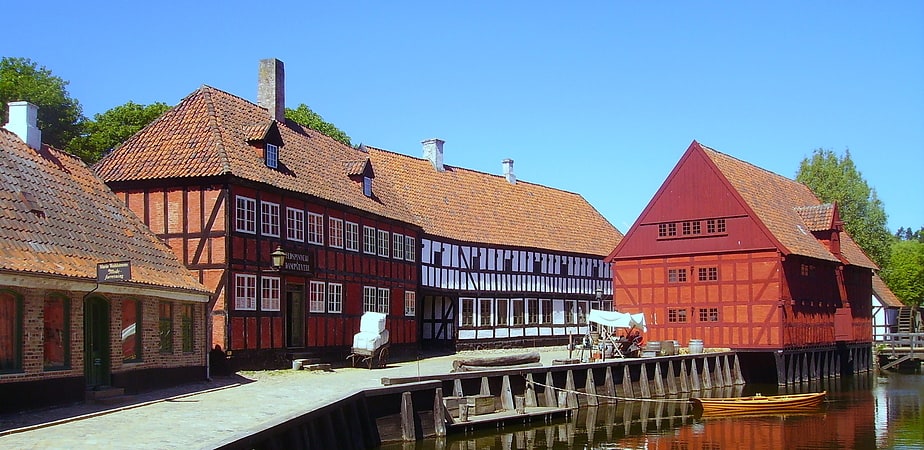
Also known as: Den Gamle By
Museum in Aarhus, Denmark. Den Gamle By, or The Old Town in English, is an open-air town museum located in the Aarhus Botanical Gardens, in central Aarhus, Denmark. In 1914, the museum opened as the world's first open-air museum of its kind, concentrating on town culture rather than village culture, and to this day it remains one of just a few top rated Danish museums outside Copenhagen, serving more than 400,000 visitors pr. year. Today the museum consists of 75 historical buildings collected from 20 townships in all parts of the country. The town itself is the main attraction but most buildings are open for visitors; rooms are either decorated in the original historical style or organized into larger exhibits of which there are 5 regular with varying themes.
The museum buildings are organized into a small town of chiefly half-timbered structures originally erected between 1550 and the late 19th century in various parts of the country and later moved to Aarhus during the 20th century. In all there are some 27 rooms, chambers or kitchens, 34 workshops, 10 groceries or shops, 5 historical gardens, a post office, a customs office, a school and a theatre. There are several groceries, diners and workshops spread throughout the town with museum staff working in the roles of town figures i.e. merchant, blacksmith etc. adding to the illusion of a "living" town.[1]
Address: Viborgvej 2, 8000 Aarhus C (Århus C)
ARoS
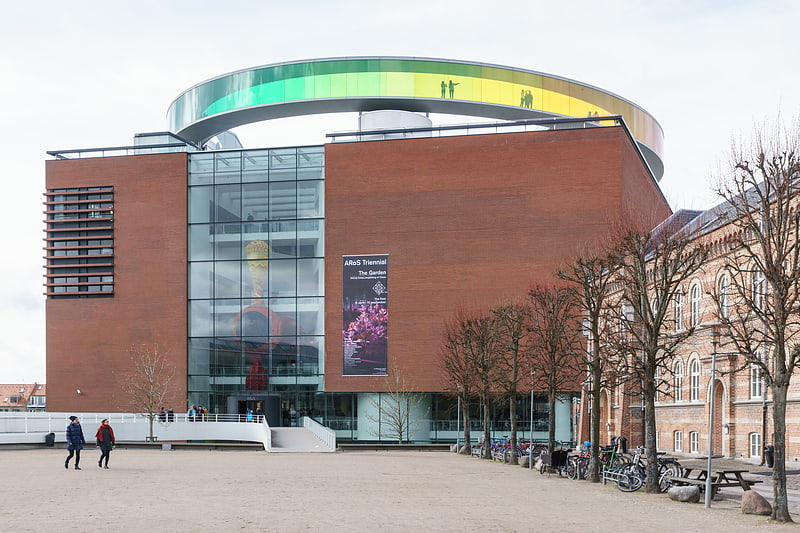
Modern art in vast contemporary venue. The ARoS Aarhus Kunstmuseum is an art museum in Aarhus, Denmark. The museum was established in 1859 and is the oldest public art museum in Denmark outside Copenhagen. On 7 April 2004, ARoS Aarhus Kunstmuseum opened with exhibitions in a brand new modern building, 10 stories tall with a total floor area of 20,700 m² and designed by Danish architects Schmidt Hammer Lassen. Today, ARoS is one of the largest art museums in Northern Europe with a total of 980,909 visitors in 2017.
Apart from the large galleries with both permanent and changing exhibitions, the ARoS building features an arts shop, a dining café and a restaurant. The architectural vision of the museum was completed in 2011, with the addition of the circular skywalk Your rainbow panorama by Ólafur Elíasson. The installation has helped boost the museum's attendance, making it the second most visited museum in Denmark, just behind the well-known Louisiana Museum in Humlebæk.[2]
Address: Aros Allé 2, 8000 Aarhus (Århus C)
Mindeparken
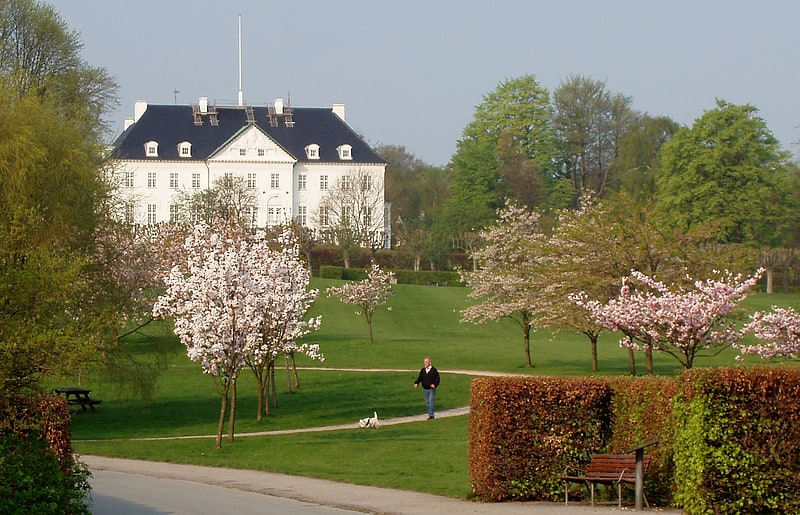
Memorial park in Aarhus, Denmark. Mindeparken is a memorial park and recreational area in the south of Aarhus City, next to Marselisborg Palace.[3]
Aarhus Cathedral
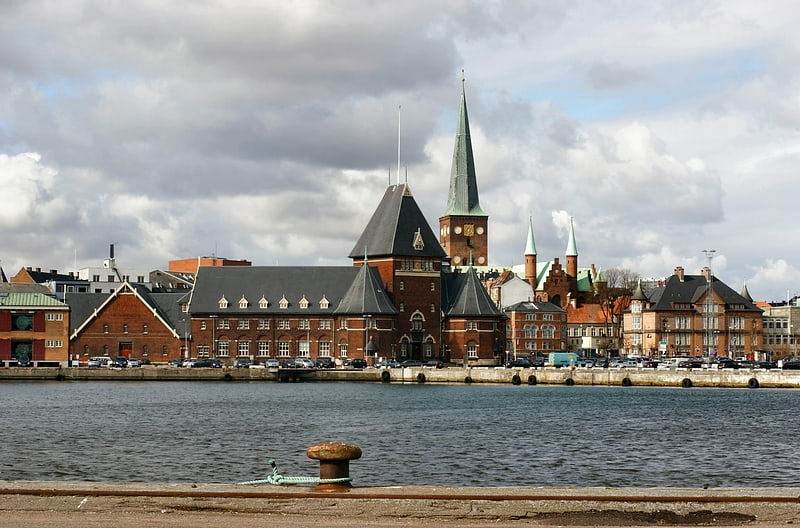
Also known as: Aarhus Domkirke
Gothic basilica with medieval frescoes. Aarhus Cathedral is a cathedral in Aarhus, Denmark. It is the longest and tallest church in the country, at 93 m in length and 96 m in height.
The construction of Aarhus Cathedral began in the 12th century and it is the main edifice of the diocese of Aarhus for the Church of Denmark, dedicated to the patron saint of sailors, St. Clemens. The cathedral is situated on the port side of the central square of Store Torv (Large Square), with address "Domkirkepladsen 2, 8000 Aarhus C, Denmark" in the inner city. The church can seat around 1200 people.[4]
Address: Domkirkepladsen 2, 8000 Århus (Århus C)
Marselisborg Forests
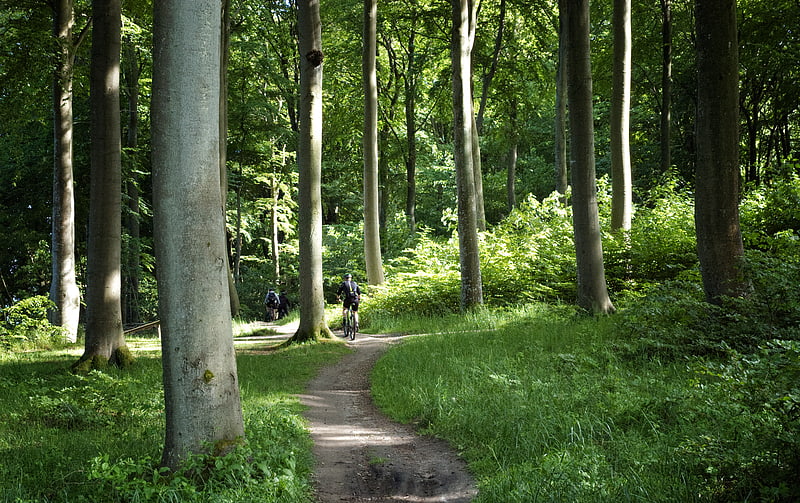
Also known as: Marselisborgskovene
Marselisborg Forests, or simply Marselisborg Forest, is a 550 hectares forest to the south of Aarhus City in the Kingdom of Denmark. Many present day sources now includes the forest of Fløjstrup, as part of the Marselisborg Forests, upping the total area with another 200 hectares. Marselisborg Forests runs along the coastline of the Aarhus Bay in a hilly terrain with steep slopes and deep gullies, especially at the shoreline. There are many traces of prehistoric activities here and the landscape have been covered by woodlands for thousands of years.[5]
Aarhus Botanical Gardens
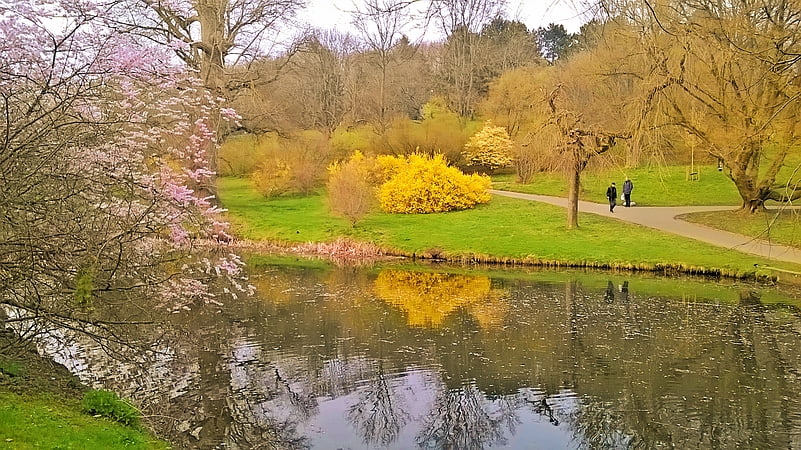
Also known as: Botanisk Have
Internationally themed botanical garden. Aarhus Botanical Gardens is a botanical garden in Aarhus, Denmark. It is located north of the Old Town open-air village museum and was founded in 1875. Nowadays it covers an area of 21.5 hectares, with 5 hectares for the Old Town.
The park was originally created primarily as a botanical and academic study-ground in relation to Aarhus University and provides an attraction of interest to those who wish to inspect the thousands of plant species on display here. All are labelled in both Latin and Danish. The landscape is quite varied and includes a large greenhouse center; originally from 1970 by C. F. Møller Architects, but with a newly added tropical hothouse. The gardens have an open-air amphitheatre, two small ponds, a children's playground and the large lawns are popular with picnics, gatherings and events of all kinds year round.
The greenhouses has been heavily renovated from 2011 to late 2014 and a large tropical dome was added, amongst other facilities. The project was budgeted at 65 million DKK and realized in a cooperation between Aarhus Municipality, Aarhus University and Realdania, with C. F. Møller Architects as architectural designers.[6]
Address: Peter Holms Vej, Aarhus (Århus C)
Moesgård

Manor house. Moesgård is a former manor house and a listed building in Aarhus Municipality. The current buildings were completed in 1778 and was listed in the Danish registry of protected buildings and places by the Danish Heritage Agency on 17 July 1918.
The manor and estate is situated in the district of Højbjerg, 10 kilometers south of the city centre of Aarhus. Administratively it belongs to the Mårslet Parish and is today owned by Moesgård Museum. The museum cooperates with the School of Culture and Society from Aarhus University on the subjects of history, archaeology, anthropology and oriental studies with most teaching and lectures being held in the manor buildings. In 2013 the university took over the buildings when a new museum building was completed and most activities related to the museum moved there.[7]
Viking Museum
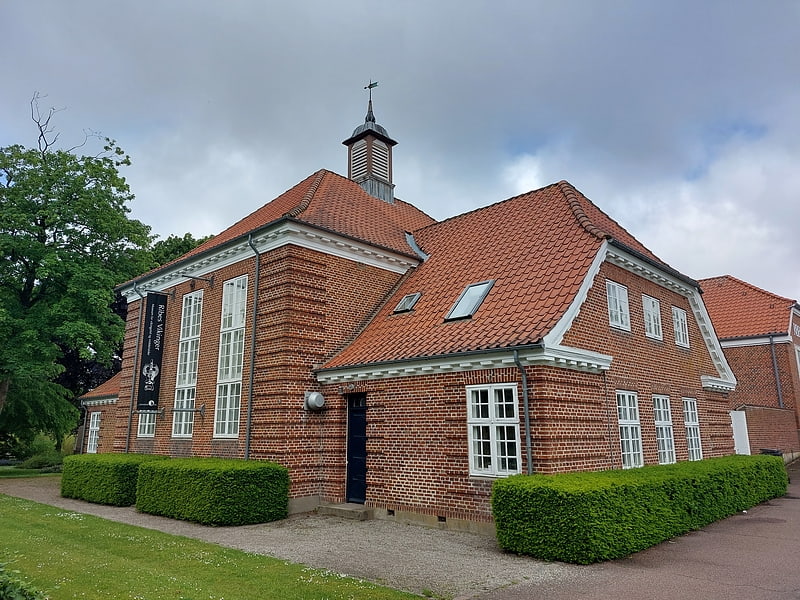
Also known as: Vikingemuseet
Viking museum with interactive exhibits. The Viking Museum is a small underground museum in central Aarhus, Denmark. It is located at Sankt Clemens Torv, beneath the Nordea bank building. The Viking Museum is administered by the Moesgård Museum and financed by both Aarhus Municipality and Nordea.[8]
Address: Sankt Clemens Torv 6, 8000 Aarhus, Aarhus (Århus C)
Marselisborg Palace

Also known as: Marselisborg Slot
Royal summer palace and English gardens. Marselisborg Palace, is a royal residence of the Danish Royal Family in Aarhus. It has been the summer residence of Queen Margrethe II since 1967.
There is a Palace Park in connection to the Palace itself and outside the grounds, stretching to the coast of the Bay of Aarhus is another large park Mindeparken (The Memorial Park), popular with the citizens of Aarhus for recreational activities in the warmer months of the year. Just south of Marselisborg Palace is Aarhus Forestry Botanical Garden and a Deer Park, as part of the extensive Marselisborg Forests. Just west and north of the Palace is Aarhus Racecourse and the Atletion Stadium.[9]
Address: Kongevejen 100, 8000 Aarhus
Egå Engsø
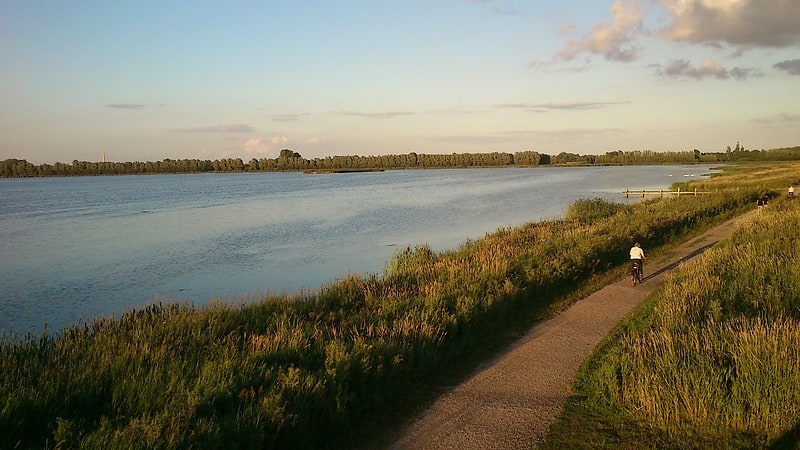
Lake in Denmark. Egå Engsø is an artificial lake and wetland site located in the north of the town of Aarhus between Vejlby, Risskov and Lystrup. Engsø means 'meadow lake' and Egå means 'oak stream', referring to the stream that drains the lake into the Aarhus bay. The lake area is bordered by the Djursland motorway to the north and the Aarhus-Grenaa railway and the municipal heating pipes from Studstrup Power Station to the south and west.[10]
Aarhus City Hall
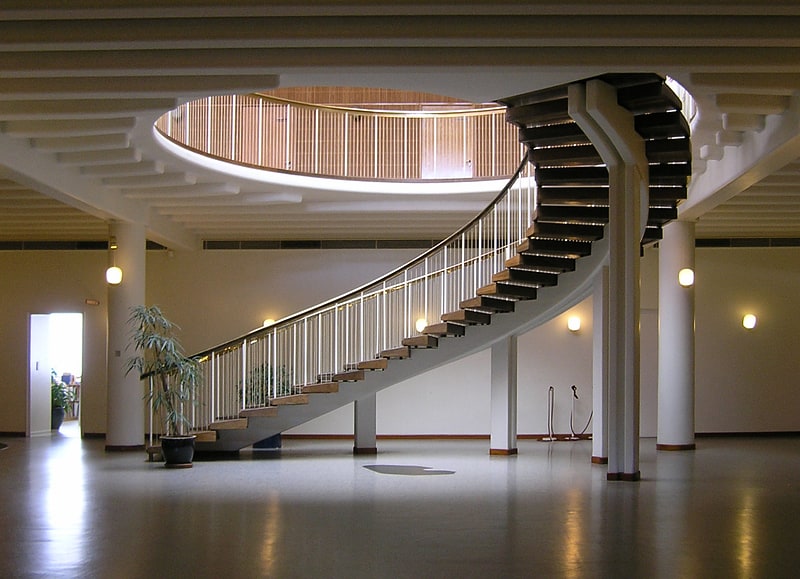
Also known as: Aarhus Rådhus
City or town hall in Aarhus, Kingdom of Denmark. Aarhus City Hall is the city hall of Aarhus, Denmark. The decision to build a new city hall was taken during a city hall meeting in 1937. The new building was inaugurated 2 June 1941, designed by architects Arne Jacobsen and Erik Møller. On the first proposal, the plans did not include a tower but due to massive public pressure it was later added to the drawings along with the idea to clad the structure in marble. Hans Wegner was in charge of the furnishing - which is uniquely designed to fit the building -, and parts of the interior design.[11]
Naturhistorisk Museum
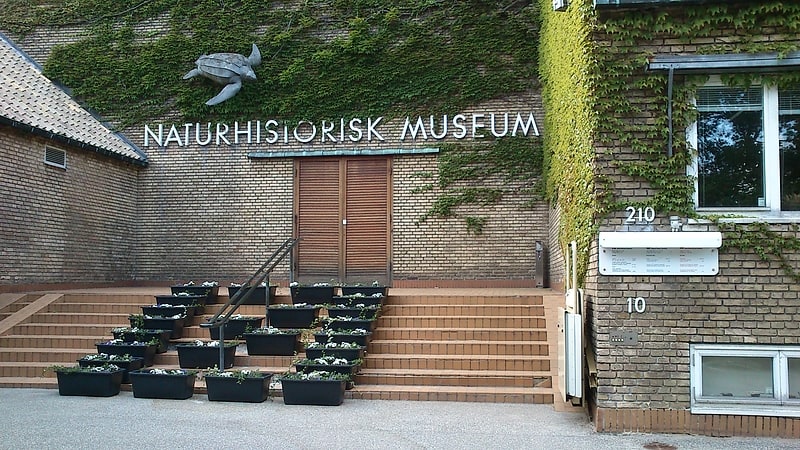
Museum in Aarhus, Kingdom of Denmark. The Natural History Museum in Aarhus is a Danish museum specializing in natural history.
The Natural History Museum is an independent institution financed with contributions from the Ministry of Culture, Aarhus Municipality, Aarhus University and revenues from visitors. The museum is situated in the Aarhus University campus in the district Midtbyen, but also operates a field laboratory and education centre, the Molslaboratoriet, in Mols Bjerge National Park on Djursland. The Natural History Museum is controlled by a board of directors composed of representatives from Aarhus University, Aarhus Municipality, the Natural History Society for Jutland, the local business community and the employees. The museum conducts research in a number of areas with focus on entomology, freshwater ecology, earth biology, fauna and bioacoustics.[12]
Address: Wilhelm Meyers Allé 10, 8000 Aarhus (Århus C)
Mollerup Skov
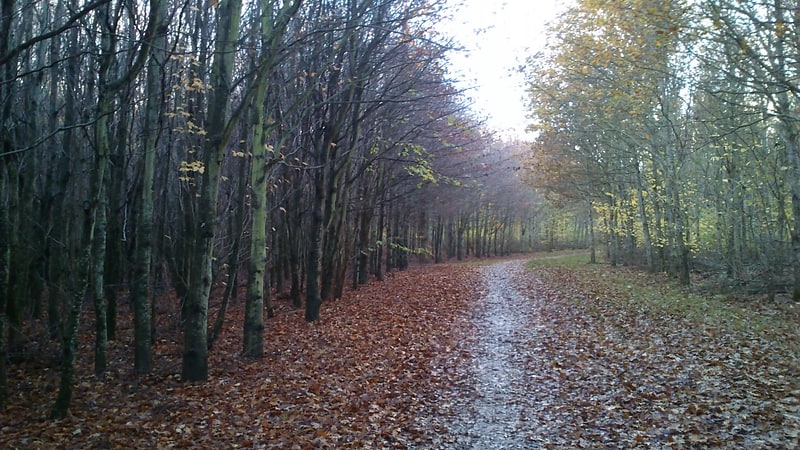
Mollerup Skov is a 97 hectare relatively new forest situated in the northern outskirts of the city of Aarhus, Denmark. In the neighbourhood of Vejlby and Skejby between Skejbyvej, Langengevej and Skejby Nordlandsvej to be precise.
Mollerup Skov is part of the New Forests of Aarhus.[13]
Address: Skejby Nordlandsvej, 8240 Risskov
Riis Skov

Riis Skov is a forest and park in Århus, Denmark. It is located south of the district of Risskov, along the Bay of Aarhus.[14]
Address: Dronning Margrethes Vej, 8200 Århus
INCUBA Science Park

INCUBA Science Park is a research park in Aarhus, Denmark with four departments in Skejby, Katrinebjerg, Aarhus University and Aarhus Docklands.
INCUBA was created as a merger of three former research institutions in 2007, and is an amalgamation of "Innovation Network Centre for University and Businesses of Aarhus" and the primary goals of the institution are to strengthen cooperation between research institutions and companies with consultancy and by raising capital for projects. The park is the first of its kind in Denmark.[15]
Marselisborg Deer Park

Also known as: Marselisborg Dyrehave
Animal park in Denmark. Marselisborg Deer Park is a 22 hectares enclosed woodland area in the northern parts of the Marselisborg Forests. The trees are somewhat sparse here and the terrain especially hilly, compared to the surrounding forest.
Marselisborg Deer Park is not a deer park in the original sense, as it is not meant for hunting deer. The idea is more like a small safari park, but just presenting a few common species, without exotic animals. Initially sika deer were introduced to graze the curvy open woodland hills, but later roe deer and wild boars has been added.
The park was established in 1932 and have since been enlarged several times. It is owned and administered by the Aarhus Municipality.[16]
Address: Ørneredevej 6, 8270 Højbjerg
Vejlby Church

Also known as: Vejlby Kirke
Lutheran church in Risskov, Denmark. Vejlby Church is a church located in Vejlby Parish in Aarhus, Denmark. The church is situated 2 kilometres north of Aarhus city centre, west of Risskov and the Bay of Aarhus, on the morainal hills of the Egå valley, with a view of Kalø Vig and Helgenæs. It is a parish church belonging to the Church of Denmark. The parish has a population of 7,148.[17]
City Hall Park

Also known as: Rådhusparken
City park in Aarhus, Denmark. Rådhusparken is a public park in central Aarhus, Denmark. The park is situated by the City Hall in the Indre By neighborhood of Midtbyen, between the streets Frederiks Allé to the west and Park Allé to the east. The park lies within a scenic semi-circle of some of the more important cultural and political institutions in the city; the Concert Hall, the ARoS Art Museum, Vester Allés Kaserne and the city hall. The City Hall Park was listed along with the adjacent city hall on 10 March 1995.[18]
Address: Frederiks Allé, 8000 Århus Centrum (Århus C)
Mølleparken
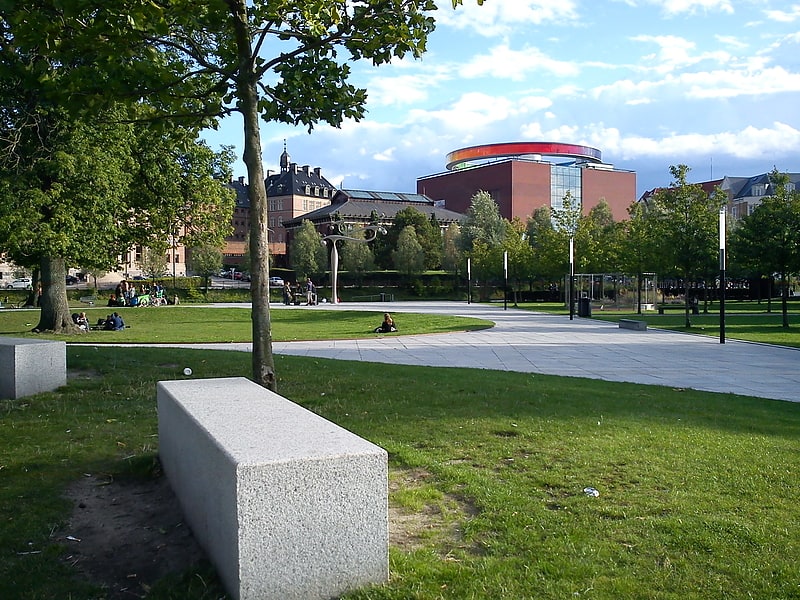
Mølleparken is a park in the city of Aarhus located in Midtbyen. Mølleparken was constructed in 1926 where the, by then obsolete, mills of the city had been situated by the river since 1289. Today the park lies by the Aarhus River and the ARoS Art Museum and functions as a section of a pedestrian arterial from ARoS to the Latin Quarter.
Mølleparken was extensively redesigned in 2006-2008, as part of the opening of the Aarhus River and now contains large areas for public recreation and facilities for street sports, including basket ball, panna, table tennis and concrete board game tables for playing chess, backgammon and checkers.
Eleven busts of notable Danish authors line the northern section of the park, namely Steen Steensen Blicher, Marie Bregendahl, J. P. Jacobsen, Johannes V. Jensen, Jakob Knudsen, Thøger Larsen, Jacob Paludan, Henrik Pontoppidan, Johan Skjoldborg, Harry Søiberg and Jeppe Aakjær. The bronze sculpture of "Elskovskampen" (the lovemaking battle) by Johannes Berg from the original park is still on display and in 2014, the kinetic sculpture Snake by Phil Price was placed here too, after acquisition by the city council. The council bought the sculpture after it received the highest rating from guests at the Sculpture by the Sea, Aarhus 2013 art festival in Tangkrogen.[19]
Address: Møllegade 1, 8000 Århus (Århus C)
Brabrand Church
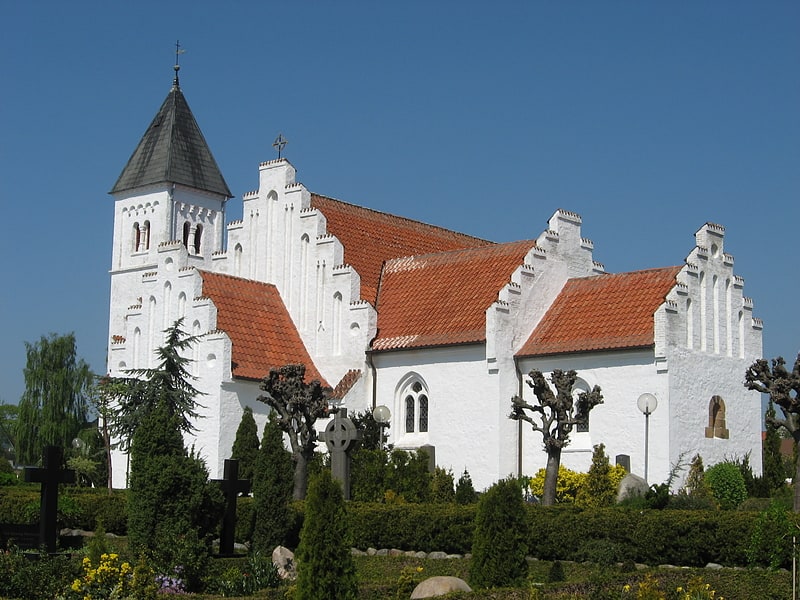
Also known as: Brabrand Kirke
Congregation in Brabrand, Kingdom of Denmark. Brabrand Church is a church located in Brabrand Parish in Aarhus, Denmark. The church is situated in the neighbourhood Brabrand by Brabrand Lake, west of Midtbyen. The church was originally devoted to St. Martin but is today a parish church in the Church of Denmark, serving a parish population of 6.962. The Brabrand Church pastorate is shared with the South Aarslev Church to the west. The resistance fighter Alf Tolboe Jensen, executed during the Second World War, is interred in the church cemetery.[20]
Address: Engdalsvej 2, 8220 Brabrand (Brabrand)
Occupation Museum
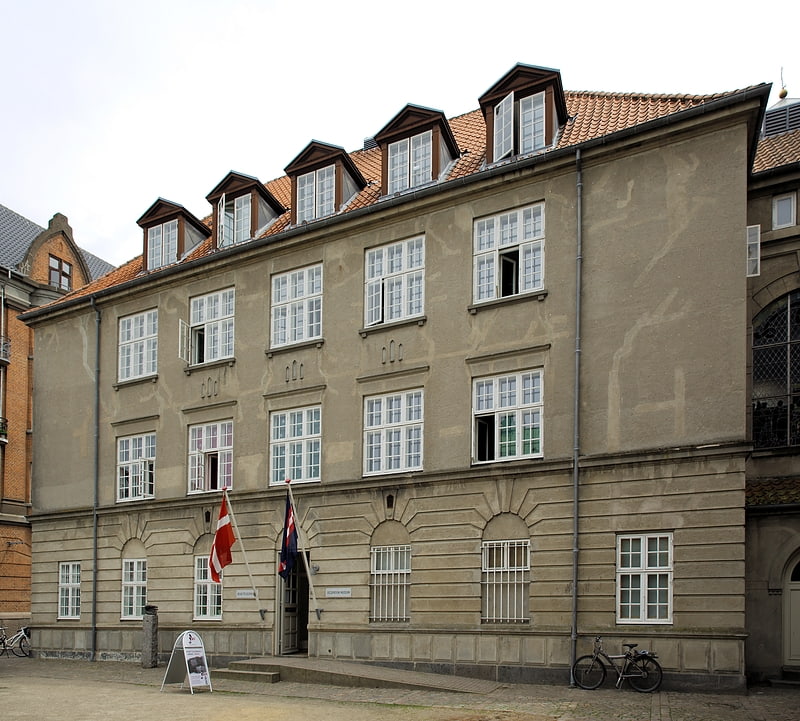
The Occupation Museum in Aarhus, Denmark is a history museum dedicated to present the history of Aarhus during the German occupation in the Second World War. The museum is situated in the historical centre, the Latin Quarter, in Midtbyen and shares the building of the Women's Museum. The building is a listed structure and it is the former city hall and police station of the city, constructed in 1856-57. In the later part of the war it served as the Gestapo headquarters for Jutland after the university buildings - where the Gestapo previously resided - were destroyed during an air raid by the Royal Air Force.
The focus of the museum is major events in Aarhus during the war especially the Aarhus Air Raid, the 1944 explosion in the Port of Aarhus, the activities of the prolific informant Grethe Bartram and the resistance movement in general. The museum exhibition make use of the history of the building as a place of interrogation and torture to tell the story of the events of the war. The cells are furnished with original items and equipment and the torture implements used at the time are on display. The exhibition features an extensive array of items from the 1940-45 period such as uniforms, weapons, mines, tools, passes and German, English and Danish propaganda.
The Occupation Museum is run by volunteers and the only revenue comes from ticket sales and donations from private individuals and organizations. In 2003 the museum went into a partnership with the museum Bymuseet and in 2008 the museum administrations were merged. In 2010 Bymuseet moved to The Old Town. From 2018 till late August 2020, the museum was closed while going through a thorough renovation and renewal. The new museum focusses on the ethical dilemmas everyday citizens were faced with during the occupation, but presented in a way that engages the visitor.[21]
University Park
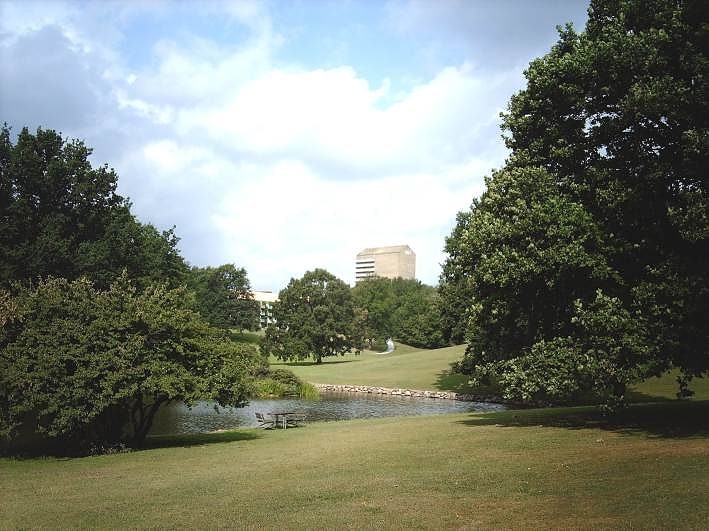
Also known as: Universitetsparken
Park in Aarhus, Denmark. Aarhus University Park or the University Park is a public park in central Aarhus, Denmark. The University Park is at the centre of Aarhus University's main campus.
As the university campus, the University Park is situated in the neighbourhood of Vesterbro in Midtbyen close to Trøjborg, and the park bounded by the streets of Nørrebrogade, Nordre Ringgade, Langelandsgade, Kaserneboulevarden and Høegh Guldbergs Gade. The park forms part of the Aarhus University campus and figures in the Danish Culture Canon for its landscape design. The combined park and campus has received international recognition for its aesthetic values, and the University Park has been protected by law since 1993, in order to conserve its unique design.
The University Park was established in 1933 in conjunction with the university. The campus master plan competition was won in 1931 by the collaborative scheme of Danish architects Kay Fisker, C. F. Møller and Povl Stegmann in collaboration with landscape architect Carl Theodor Sørensen who designed the park.
The park is encircled by the university buildings, including the Natural History Museum and dormitories. It is constructed across an undulating landscape in parts of an old moraine valley stretching from Katrinebjerg in Vejlby, in the north, to the Bay of Aarhus in the east. The park is characterized by its oak trees, two artificial lakes, home to water fowl and amphibians, and large open, grassy areas. A small stream runs north-south in the bottom of the valley from the amphitheatre to the lakes. The adjoining Vennelystparken to the south, contrasts the University Park with a different terrain and fauna and mixed tree growth.
In 1949, an amphitheatre was added below the main building of the university and it has become a central element in recreational activities in the park. Annually a boat race is held in the lakes between the faculties of the university, which has become a public event.[22]
Address: Victor Albecks Vej, 8000 Aarhus C (Århus C)
Concert Hall Park
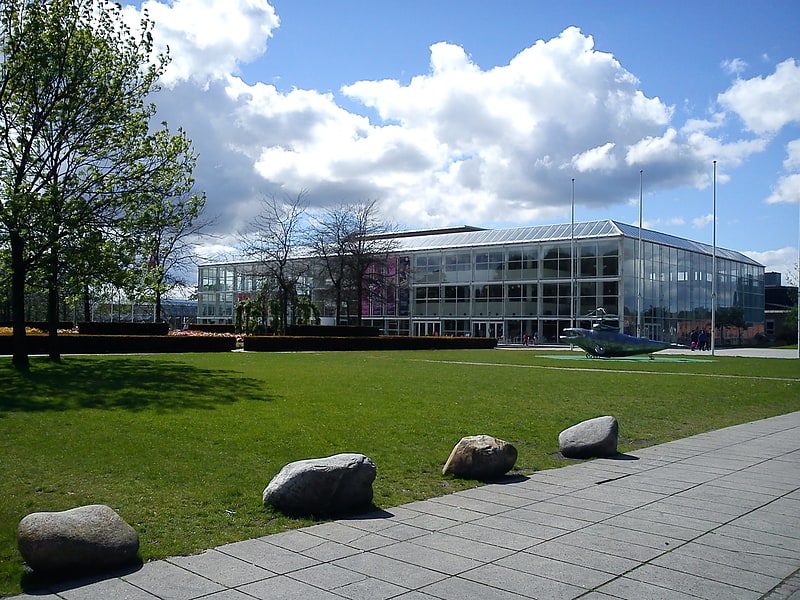
Also known as: Musikhusparken
The Concert Hall Park is a public park in central Aarhus, Denmark. The park is laid out in front of the Aarhus Concert Hall main entrances in the Indre By neighborhood of the inner city. It is bordered by the street Frederiks Allé to the east, Thomas Jensen's Allé to the south and Vester Allé to the north, behind the historic buildings of the former Vester Allés Barracks. The park is named after the Aarhus Concert Hall which is situated prominently immediately west of the park. The Concert Hall Park forms a center-point between some of the most prominent buildings in the city, the ARoS Aarhus Art Museum, Vester Allé Barracks, the concert halls, and Aarhus City Hall in view behind the City Hall Park across Frederiks Allé. The Concert Hall Park was designed by the landscape architect Sven Hansen as a parterre garden, and it was established in the 1980s.
The Concert Hall Park is divided geographically in two separate sections. The main section between Frederiks Allé and the Concert Hall entrances is designed as a parterre garden. The more secluded northward section is fit in between the concert halls and the ARoS art museum on a steep slope, and includes an amphitheatre and outdoor stage. The Concert Hall Park and the adjacent City Hall Park is separated by the Frederiks Allé road and have very different designs. Whereas the City Hall Park has winding paths, dense growth and an organic, sort of haphazard, design, the Concert Hall Park has an ordered, tight expression with straight paths, cropped hedges and diagonal axis' mirroring planning and order. In the central areas where paths join there are a number of fountains and benches.
The amphitheatre and outdoor stage of the Concert Hall Park is used for various events and concerts, including the SPoT Festival and Aarhus Festuge. It can accommodate 5-6000 people, depending on the setup.[23]
Viby Kirke

Church in Viby J, Denmark. Viby Church is a church located in Viby Parish in Aarhus, Denmark. The church is situated in the neighbourhood Viby, west of Marselisborg. It is a parish church which belongs to the Church of Denmark and there's population of 8.211 within the parish borders.[24]
Address: Kirkestien 3, Aarhus
Catholic Church of Our Lady
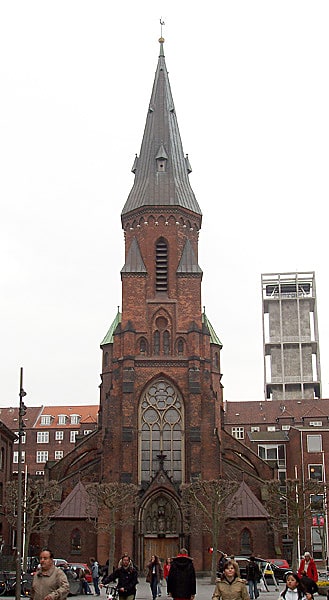
Also known as: Vor Frue Kirke
Catholic church in Aarhus, Denmark. Catholic Church of Our Lady is a church in Aarhus, Denmark. The church is situated in the central Indre By neighbourhood on the pedestrian street Ryesgade, close to the Central Station and City Hall. It is a catholic church under the Roman Catholic Diocese of Copenhagen; built between 1877 and 1880 by designs of the German architect Franz Schmitz and later renovated by the architect Carl R. Frederiksen. The church has seating for 500 people.
The congregation is the largest catholic congregation in Denmark consisting of some 3500 members from 89 different countries. Especially Vietnam is well-represented but also Iraq, Poland, Chile and Germans.[25]
St. Paul's Church
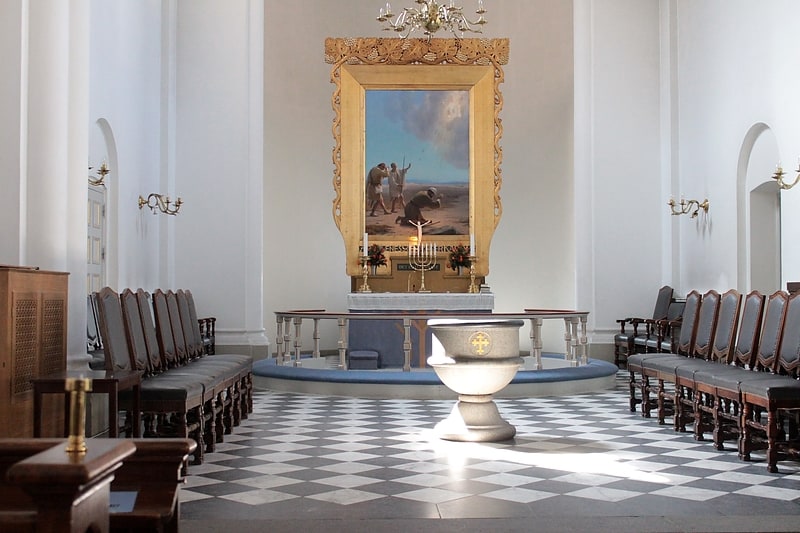
Also known as: Sankt Pauls Kirke
Parish church in Aarhus, Kingdom of Denmark. St Paul's Church is a parish church in Aarhus, Denmark. It was completed in 1887 to a design by Vilhelm Theodor Walther in the Neo-Romanesque style.[26]
Address: Sankt Pauls Kirkeplads 1, 8000 Aarhus (Århus C)
Moesgård Forest Mill
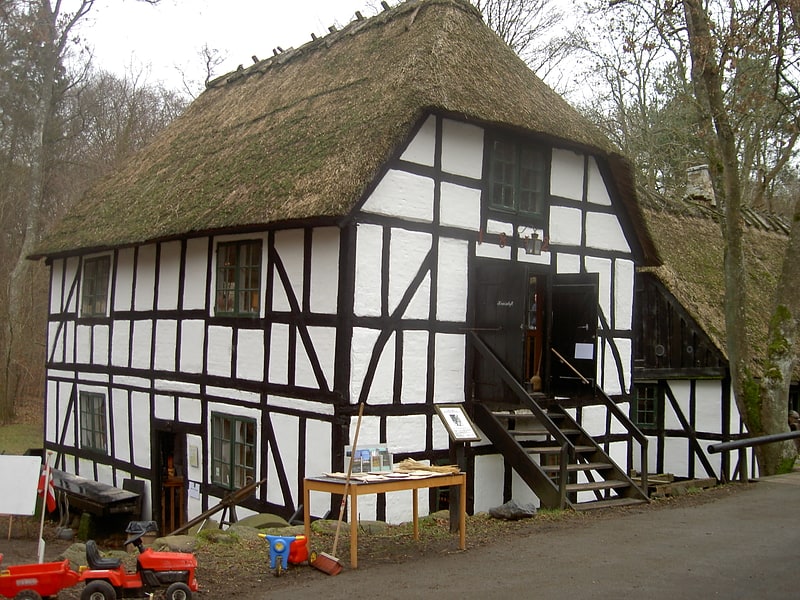
Also known as: Moesgård Skovmølle
Building in Denmark. Moesgård Forest Mill is a mill and a listed building in Aarhus, Denmark. The mill was built in 1785 and was listed on the Danish registry of protected buildings and places by the Danish Heritage Agency on 13 April 1984. The mill is situated in the Marselisborg Forests just south of the suburb Skåde and Moesgård Museum, some 6 km. south of Aarhus city center.[27]
Vennelystparken
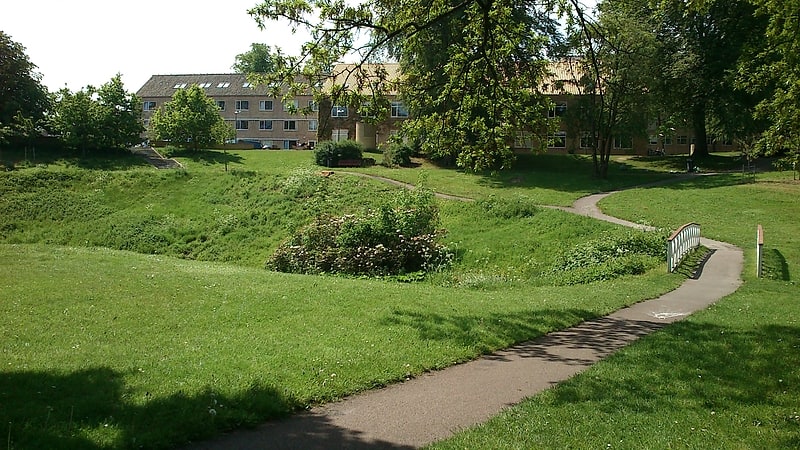
Park in Aarhus, Kingdom of Denmark. Vennelystparken is the oldest park in the city of Aarhus, constructed in the years 1824 to 1830 between the streets Vennelyst Boulevard and Nørrebrogade. Through the 19th century up to the Second World War the park was a social focal point in Aarhus hosting revues, circusses, plays and concerts in changing venues. The park is now part of the Aarhus University campus in Midtbyen. The park no longer has any venues but is frequently used for open-air concerts and protests and functions as the local park of the neighborhood Øgadekvarteret.
Vennelystparken contains large undulating, grassy areas with a lake and stream cutting through, and is characterized by beech and chestnut trees.[28]
Address: Høgh Guldbergs gade, Aarhus (Århus C)
Kunsthal Aarhus
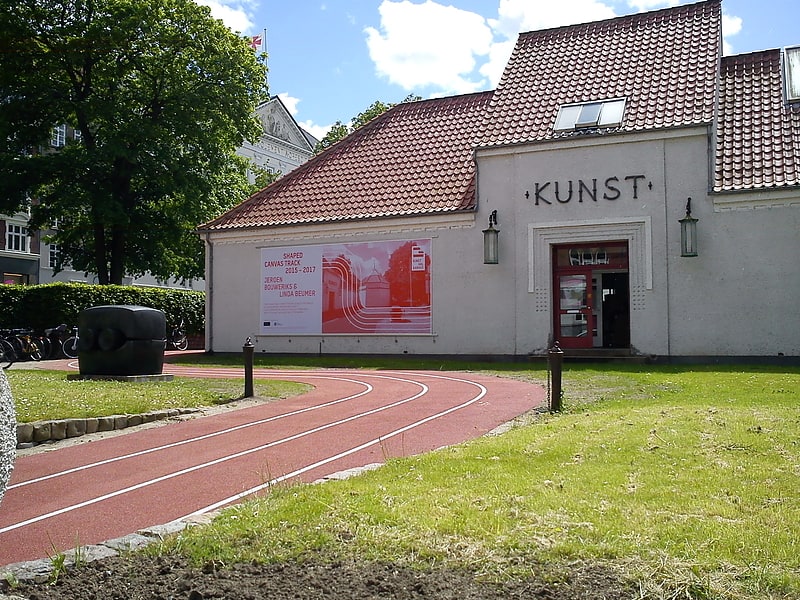
Art institute in Aarhus, Kingdom of Denmark. Kunsthal Aarhus is a contemporary arts centre located at the heart of the city of Aarhus in Denmark.
The institution initiates, commissions, produces and presents art at an international level to local, regional, and international audiences. Kunsthal Aarhus has its focus on cutting edge art in a broad context and to a wide audience, as part of a sustainable approach. It provides a research based participatory, collaborative and transdisciplinary platform for artistic experimentation and critical engagement. Kunsthal Aarhus strives to be an inclusive, transparent, dynamic and flexible institution that fosters the culture of appreciation and values diversity of contributions.[29]
Address: J. M. Mørks Gade 13, 8000 Aarhus (Århus C)
Tangkrogen
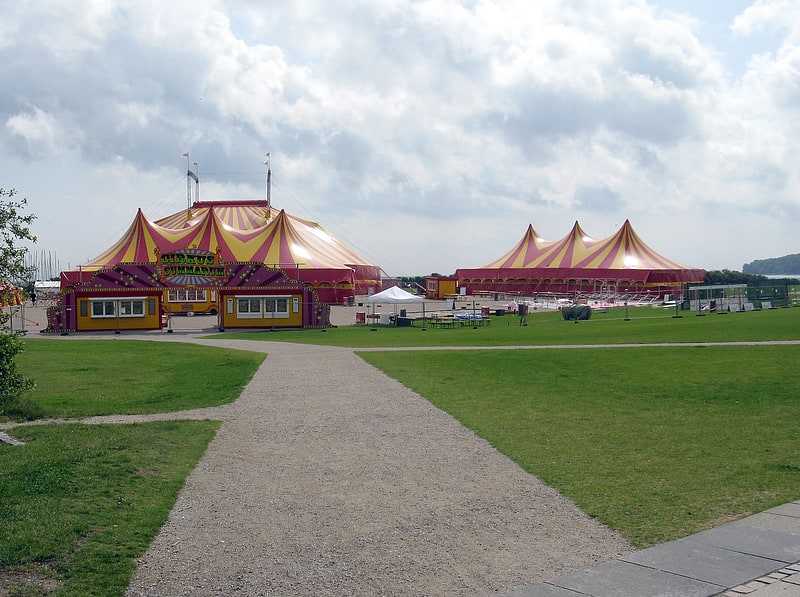
Park in Aarhus, Denmark. Tangkrogen is a public park in Aarhus, Denmark. The park is situated in the neighborhood Midtbyen by the coast with the Bay of Aarhus to the southeast, the Marselisborg neighborhood to the West and the Port of Aarhus to the North. The park is bounded by Strandvejen and Marselis Havnevej across from Chr. Filtenborgs Square. It is a municipal park managed by the Nature and Environment department of Aarhus Municipality. Tangkrogen got its name from the kelp that filled the cove when recreational jetties were constructed when the city of Aarhus initially developed the area into a public park in the early 20th century.[30]
Randersvej Water Tower
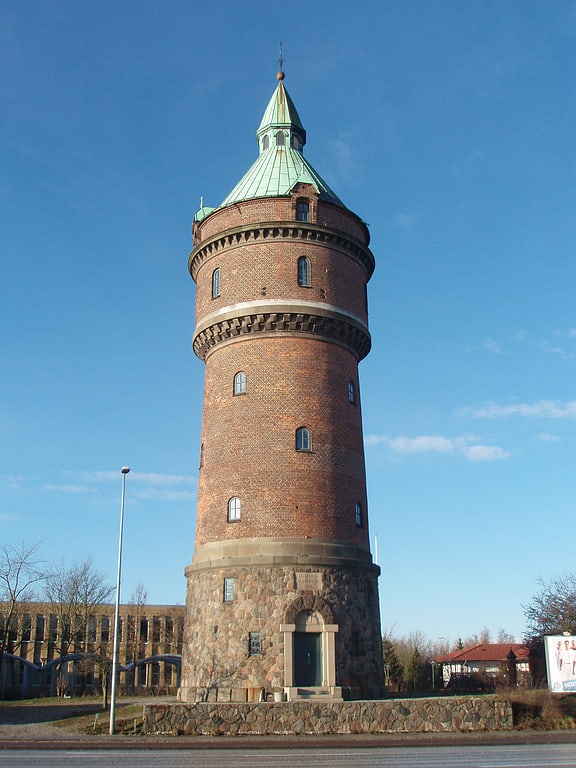
Randersvej Water Tower is a former water tower on Randersvej in Aarhus, Denmark. It is listed for preservation.[31]
Christianskirken
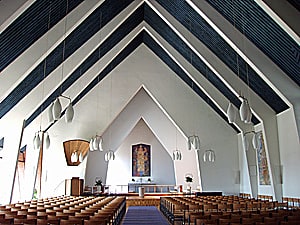
Also known as: Christians Kirke
Christians's Church is a church in Aarhus, Denmark. The church is situated in the northern Christiansbjerg neighbourhood on Frederikshaldsgade. It is a parish church, and the only church in Christians Parish, under the Diocese of Aarhus and within the Church of Denmark, the Danish state church. The church serves some 14.000 parishioners in Christians Parish and holds weekly sermons along with weddings, burials and baptisms.
The present Christians's Church was inaugurated on 2 March, 1958. The congregation in Christiansbjerg had for some years made do with a crypt, built during the Second World War, which had doubled as a temporary church. The crypt church replaced an older Christian's Church which had been in use since 1913 to 1946. The old church was found too small with just 90 seats, and an architects' contest was established in 1937 to find a design for a new church. The contest was won by Aage C. Nielsen. A committee led by the bishop of the Diocese of Aarhus started raising funds for the new church but war and occupation delayed the project. The funds were used to build the crypt church which had to double as a church until the 1950s.
Minister of Ecclesiastical Affairs Bodil Koch made the project a priority and construction on the new church began in 1957. The resulting church was characteristic with sharp lines and a hexagonal church tower. The porch is low and leads into a large, tall church room which can seat 500 people. The church room stretches to the roof with the aid of buttresses which gives the otherwise modernistic church a gothic element. The south wall is one large window which is the main source of light. The church exterior is made of red brick.[32]
Address: Frederikshaldsgade 15, 8200 Århus
Vilhelmsborg

Building in Mårslet, Denmark. Vilhelmsborg is the National Equestrian Centre of Denmark and a listed building in Aarhus Municipality. The main manor building was completed in 1842 and was listed by the Danish Heritage Agency on 3 March 1945. The manor lies 10 km. south of Aarhus, by Beder-Malling in Mårslet Parish, and is today owned by Aarhus Municipality along with 288 hectares of adjoining land.
In the 19th century H. C. Andersen lived on the Vilhelmsborg estate on several occasions and some of his fairy tales are said to have been inspired by the view of Mols from his window. Johan Skjoldborg also frequented the estate and his novel Gyldholm depicts the hardships of farm hands by the end of the 19th century.[33]
Address: Bedervej 101, Aarhus
Skanseparken

Park in Aarhus, Denmark. Skanseparken is one of the oldest parks in the city of Aarhus. It is situated in the neighborhood of Frederiksbjerg in Midtbyen. Skanseparken was constructed in the years 1901 to 1902 between the streets Strandvejen, Marselisborg Allé and Heibergsgade. The park is typical of the parks in the city with large, open areas bounded by beech trees, raised flower beds and playgrounds. It is a popular area for festivals, concerts and other cultural events.
The name of the park refers to the sconce erected by Albrecht von Wallenstein on the site when he occupied the city and used it as a base for raids throughout Jutland in 1627 during the Thirty Years' War. In 1898 the area was bought by a developer in Marselisborg and subsequently annexed by the city. Two large residential complexes known as Skansen (The Sconce) and Skansepalæet (The Sconce-mansion) overlooking the small park in the north, both refers to the former sconce here.
Skanseparken contains a bust of Hendrik Pontoppidan by the sculptors Vilhelm Bissen and Rasmus Andersen.[34]
Kolt Church
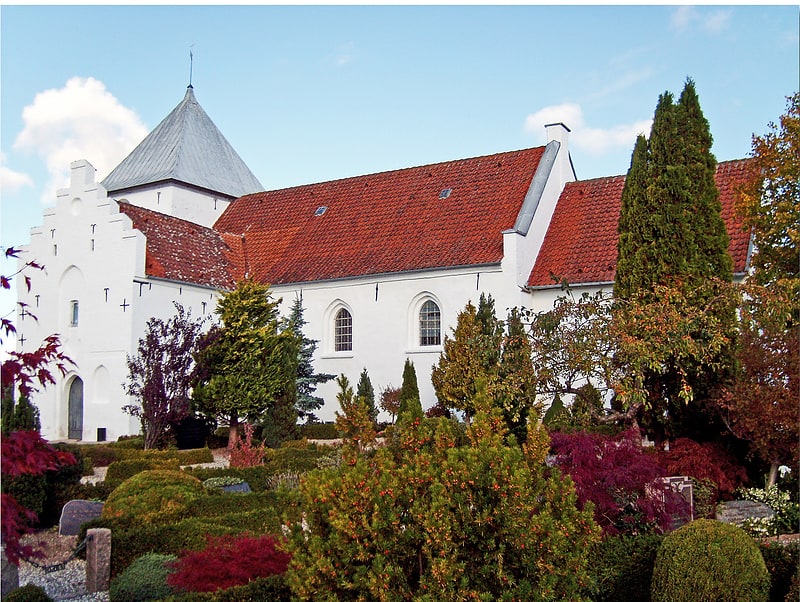
Also known as: Kolt Kirke
Church in Hasselager, Denmark. Kolt Church is a church located in Kolt Parish in Aarhus, Denmark. The church is situated in the Hasselager neighborhood, south-west of Viby. It is a parish church of the Church of Denmark and there's population of 6.973 within the parish borders.[35]
Address: Kunnerupvej 101, 8361 Hasselager